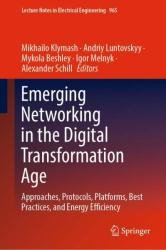Emerging Networking in the Digital Transformation Age: Approaches, Protocols, Platforms, Best Practices, and Energy Efficiency
- Добавил: literator
- Дата: 22-03-2023, 04:09
- Комментариев: 0
 Название: Emerging Networking in the Digital Transformation Age: Approaches, Protocols, Platforms, Best Practices, and Energy Efficiency
Название: Emerging Networking in the Digital Transformation Age: Approaches, Protocols, Platforms, Best Practices, and Energy EfficiencyАвтор: Mikhailo Klymash, Andriy Luntovskyy, Mykola Beshley, Igor Melnyk
Издательство: Springer
Год: 2023
Страниц: 693
Язык: английский
Формат: pdf (true)
Размер: 59.7 MB
This book covers a range of leading-edge topics. It is suitable for teaching specialists for advanced lectures in the domains of systems architecture and distributed platforms. Furthermore, it serves as a basis for undergraduates as well as an inspiration for interesting postgraduates, looking for new challenges. It addresses a holistic view of QoS, which becomes nowadays via Digital Transformations less technically and more socially driven. This includes IoT, energy efficiency, secure transactions, blockchains, and smart contracting.
Under the term Emerging Networking (EmN), we cover the steadily growing diversity of smart mobile and robotic apps and unmanned scenarios (UAV). EmN supports distributed intelligence across the combined mobile, wireless, and fixed networks in the edge-to-cloud continuum. The 6G driving factors and potentials in the mid-term are examined. Operative (emergency) networking, which assists rescue troops at sites, also belongs to the above-mentioned problems. The EmN architecture includes the components of SDN, blockchain, and AI with efficient slicing and cloud support.
Chapter 1, is titled Emerging Network Technologies for Digital Transformation: 5G/6G, IoT, SDN/IBN, Cloud Computing, and Blockchain. The chapter starts with a discussion of the state of the art in the development of network technologies for the global digitalization of society, including new trends and future research directions. The importance and necessity of active development of network technologies are also emphasized. In particular, the top ten trending network technologies that will play an important role in a comprehensive digital transformation are highlighted. The authors have developed unique concepts and concise explanations of such emerging technologies as follows: the Internet of Things, software-defined networking, network function virtualization, (Docker) container networking, cloud computing, edge computing and AI, information-centric networking and services, time-sensitive and deterministic networking, 5G/6G (generation) mobile networks, AI-based networking, and many other contexts related to advanced communications. Furthermore, it is emphasized that all emerging network technologies discussed in this chapter should be combined to organize new digital infrastructures in different deployment scenarios and use cases. Only then will we be able to achieve the necessary capabilities to optimize the performance and efficiency of different infrastructures in the new era of digital transformation.
Chapter 5, under the title Smart Home: Protocols, Platforms and Best Practices, is dedicated to the development of modern digital platforms for smart homes. Scientific and technological progress and digitalization are moving at a very fast manner, making life easier, more convenient and better. One of such innovations is the construction of a smart home based on advanced network technologies. Wireless data transmission technologies have become widespread: Bluetooth, Wi-Fi, ZigBee, LoRa, NB-IoT, and other. In this chapter, the basic concepts for so-called smart home systems are investigated, existing protocols for the construction of “smart home” are considered, as well as design schemes are presented. The authors solve some practical problems of compatibility of network and IoT components as well as consider pros and cons for conformity and independence from the vendor’s and cloud functionalities. Some issues of bottlenecks in existing platforms in terms of network security and data privacy are presented.
In Chapter 6, titled Construction and Methods for Solving Problems at the SDN Control Level, the authors have focused on improving the efficiency of SDN functionality, which is a key technology for the implementation of the overall concept of digital transformation by telecom operators. Transferring the management to a central controller, which understands the full topology of the network, allows to increase the efficiency of utilization of all connections and optimally utilize the resources of hardware devices. To obtain optimal solutions in the network resource management process, the authors formalize a number of mathematical management models. The solution of mathematical models allows obtaining numerical values of throughput and quality of service indicators in different modes of network operation.
Скачать Emerging Networking in the Digital Transformation Age: Approaches, Protocols, Platforms, Best Practices, and Energy Efficiency
[related-news] [/related-news]
Внимание
Уважаемый посетитель, Вы зашли на сайт как незарегистрированный пользователь.
Мы рекомендуем Вам зарегистрироваться либо войти на сайт под своим именем.
Уважаемый посетитель, Вы зашли на сайт как незарегистрированный пользователь.
Мы рекомендуем Вам зарегистрироваться либо войти на сайт под своим именем.
